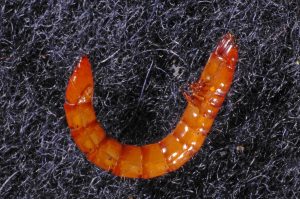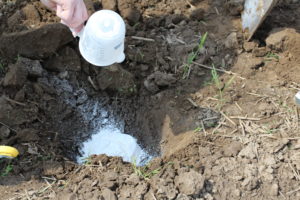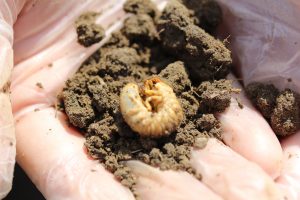Soil temperatures are at 10 degrees C which means that wireworms and grubs are active near the soil surface. So it is also a great time to set up wireworm baits or dig for grubs.

For the 2017 planting season, growers wanting to purchase and plant neonic treated corn and soybean seed require a pest assessment report (PAR) through an Inspection of Soil. PARs are valid for 12 months from the day that the assessment was completed so if you have a report that hasn’t expired yet for the same 100 acres or less on farm property identified in the report, it can still be used this season to purchase the seed to be planted on that 100 acres.
If a new PAR is needed, the inspection of soil must be conducted by an IPM certified person who has taken the course at: https://www.ipmcertified.ca/. The person who purchases the seed must also be an IPM certified person. Starting August 31st, 2017, those farm properties within the counties identified in Schedule 1 will require a Professional Pest Advisor to conduct the inspection of soil for the 2018 growing season.
A reminder from a previous post on how to conduct an Inspection of Soil is below, including various resources that you may find helpful.
Soil Inspection Pest Assessment – For every 100 acre or less plot on a farm property, baits or digging need to be done in 5 areas of the field. Look for higher risk areas of the fields to focus your scouting efforts, though each of the 5 scouting areas need to be 10 metres apart from each other. High risk areas of the field include sandy or silty areas of the field, especially knolls, areas where grassy weeds are prevalent, or in areas where gaps in the stand have been noticed in the past.

To set up wireworm baits:
- Dig a hole approx 15 cm by 15 cm by 15 cm deep
- Place a cup of bait in the bottom of the hole. Baits can be made of:
- 1 cup of all-purpose flour – moisten with some water once placed in the hole or
- 1 cup of equal parts of untreated corn, wheat and beans that has been soaked overnight.
- Break up any clumps of soil that was dug up and mound the soil over the bait.
- To deter predators and keep the bait moist and warm, place a black plastic bag over the bait station and cover the corners of the plastic with soil so that it doesn’t blow away.
- Place a flag at the station so you can find it again.
- Return 7 to 10 days later to dig up the bait. Break up the bait to search for the presence of wireworms.
Do this for at least 5 locations in the 100 acre or less plot, each bait station being at least 10 metres apart from each other. Experience has taught us that predators like to pull up the baits so place more than is required to ensure that there are five still left to assess.
To dig for wireworms or grubs:

- Dig a hole approximately 30 cm by 30 cm wide to about 7 to 10 cm deep.
- Sift through the soil that was removed from the hole, breaking up any larger clumps.
- Search and record any wireworms or grubs found in the hole or the soil that was removed.
Do this digging method for at least 5 locations in the plot, each location being at least 10 metres apart from each other.
Remember, don’t confuse millipedes for wireworms. Click here to see the differences.
The threshold to purchase and use (plant) neonicotinoid treated corn or soybean seed is an average of 1 wireworm or 2 grubs averaged over 5 scouting locations per 100 acre plot. If this threshold is met, fill out the Inspection of Soil – Pest Assessment Report and provide a copy to your seed vendor(s).
Additional Resources:
Guide to Early Season Field Crop Pests
Pest Manager app: Android iPhone, iPad
Integrated Pest Management Course for Corn and Soybeans Manual
Neonicotinoid Regulations for Ontario Corn and Soybean Growers
